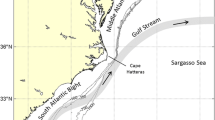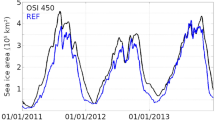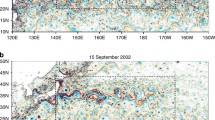Abstract.
Interannual-to-interdecadal ocean–atmosphere interaction in midlatitudes is studied using an idealized coupled model consisting of eddy resolving two-layer quasi-geostrophic oceanic and atmospheric components with a simple diagnostic oceanic mixed layer. The model solutions exhibit structure and variability that resemble qualitatively some aspects of the observed climate variability over the North Atlantic. The atmospheric climatology is characterized by a zonally modulated jet. The single-basin ocean climatology consists of a midlatitude double jet that represents the Gulf Stream and Labrador currents, which are parts of the subtropical and subpolar gyres, respectively. The leading mode of the atmospheric low-frequency variability consists predominantly of meridional displacements of the zonal jet, with a local maximum over the ocean. The first basin-scale mode of sea-surface temperature has a red power spectrum, is largely of one polarity and bears qualitative similarities with the observed interdecadal mode identified by Kushnir. A warm sea-surface temperature anomaly is accompanied by anomalously low atmospheric pressure, an intensified model Gulf Stream and a weakened Labrador current. This mode is found not to be affected significantly by oceanic coupling. In the western part of the basin, this sea-surface temperature pattern is shown to be forced by the slowest components of the surface-wind anomaly through a delayed modulation of the baroclinic time-dependent boundary currents which advect mean SST, with synchronous variations in the two oceanic jets. The response in the east is found to be dominated by local atmospheric forcing. Basin-scale intrinsic oceanic variability consists of a damped oceanic oscillatory mode in the baroclinic flow field that is excited by the atmospheric noise. Its period is around 5.5 years, but it has a negligible influence on the evolution of sea-surface temperature. Important for this mode's excitation is the meridional position of the atmospheric center of action relative to the ocean gyres.
Similar content being viewed by others
Author information
Authors and Affiliations
Additional information
Electronic Publication
Rights and permissions
About this article
Cite this article
Kravtsov, .S., Robertson, .A. Midlatitude ocean–atmosphere interaction in an idealized coupled model. Climate Dynamics 19, 693–711 (2002). https://doi.org/10.1007/s00382-002-0256-6
Received:
Accepted:
Issue Date:
DOI: https://doi.org/10.1007/s00382-002-0256-6




